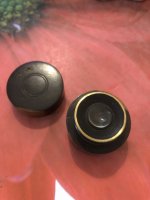EE THr
Silver Member
Do The Math!
The LRL promoters were complaining about personal insults, in a couple other threads here, so there won't be any personal insults here. Just the mathematics of LRLs, and of LRLs compared to other equipment.
First let's establish the success rate percentage math, and what it means.
If you toss a coin, the random odds of guessing which side will land up, is 50-50. In percentages, this is expressed as an average success rate of 50%.
So, if any type of locating device is used to select between two unknown targets, with one of them being an agreed upon desireable target, and the other not, you would have the same random chance of 50-50 for just guessing---with or withour any locating device.
That means that a success rate of 50%, for a locating device, is really zero, because it's no better than random chance or just guessing.
So, the only percentages that are significant for testing dowsing or LRLs, are those between 50 and 100. Because anything less would mean that the locating device is doing nothing better than someone just guessing.
Since the whole LRL question revolves around the claim that LRLs are better than just dowsing, then it should stand to reason that, if dowsing and LRLs do work, the LRLs would have a significantly better average percentage of success than mere dowsing, right?
Now we have something to work with. Just the data, and no need for insults, right? Straight math. Good.
Furthermore, it has been claimed that a couple coat hangers (thank you SWR) will work as well as anything for standard dowsing rods. Now we can do the math, comparing the retail price of coat hangers to the retail price of an LRL device.
Since most metal coat hangers are free, let's assign them a hidden cost of 50 cents, since whoever gives them out with their laundry does have to pay for them, and that cost is passed on to the consumer. And since most people use two, that's a total cost of $1.00 to dowse.
Now we can compare the cost ratio of any particular LRL-to-coat hangers, with ratio of success percentage of the same LRL-to-coat hangers, right?
But remember, the success percentage of both dowsing, and LRLs, begins at 50% equals zero success above random guessing chance. So tests resulting in 50% success or less, must be calculated into the over all average success rate, but do not by themselves indicate any success at all.
Now we can express the value of, for example, a RangerTell LRL, by comparing it's cost ratio to it's success ratio.
No insults, no opinions, no bias. Just pure, simple math. Just the data, folks!
Fair enough?

The LRL promoters were complaining about personal insults, in a couple other threads here, so there won't be any personal insults here. Just the mathematics of LRLs, and of LRLs compared to other equipment.
First let's establish the success rate percentage math, and what it means.
If you toss a coin, the random odds of guessing which side will land up, is 50-50. In percentages, this is expressed as an average success rate of 50%.
So, if any type of locating device is used to select between two unknown targets, with one of them being an agreed upon desireable target, and the other not, you would have the same random chance of 50-50 for just guessing---with or withour any locating device.
That means that a success rate of 50%, for a locating device, is really zero, because it's no better than random chance or just guessing.
So, the only percentages that are significant for testing dowsing or LRLs, are those between 50 and 100. Because anything less would mean that the locating device is doing nothing better than someone just guessing.
Since the whole LRL question revolves around the claim that LRLs are better than just dowsing, then it should stand to reason that, if dowsing and LRLs do work, the LRLs would have a significantly better average percentage of success than mere dowsing, right?
Now we have something to work with. Just the data, and no need for insults, right? Straight math. Good.
Furthermore, it has been claimed that a couple coat hangers (thank you SWR) will work as well as anything for standard dowsing rods. Now we can do the math, comparing the retail price of coat hangers to the retail price of an LRL device.
Since most metal coat hangers are free, let's assign them a hidden cost of 50 cents, since whoever gives them out with their laundry does have to pay for them, and that cost is passed on to the consumer. And since most people use two, that's a total cost of $1.00 to dowse.
Now we can compare the cost ratio of any particular LRL-to-coat hangers, with ratio of success percentage of the same LRL-to-coat hangers, right?
But remember, the success percentage of both dowsing, and LRLs, begins at 50% equals zero success above random guessing chance. So tests resulting in 50% success or less, must be calculated into the over all average success rate, but do not by themselves indicate any success at all.
Now we can express the value of, for example, a RangerTell LRL, by comparing it's cost ratio to it's success ratio.
No insults, no opinions, no bias. Just pure, simple math. Just the data, folks!
Fair enough?



 No, we go out in the yard or fields and
No, we go out in the yard or fields and

